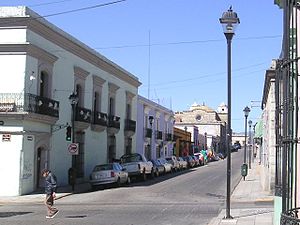Capture of Oaxaca (1812)
| Siege of Acapulco | |||||||
|---|---|---|---|---|---|---|---|
| Part of the Mexican War of Independence | |||||||
 A street view from the colonial part of Oaxaca, taken by Morelos in 1812. |
|||||||
|
|||||||
| Belligerents | |||||||
|
|
|
||||||
| Commanders and leaders | |||||||
|
|
|
||||||
| Strength | |||||||
| ~5,000 soldiers | 2,000 soldiers | ||||||
The Capture of Oaxaca was a battle during the War of Mexican Independence that occurred on 25 November 1812 at Oaxaca, Oaxaca. It was fought between the royalist forces loyal to the Spanish crown, commanded by General Antonio Pío González-Saravia Mollinedo, and the Mexican rebels fighting for independence from the Spanish Empire, commanded by José María Morelos y Pavón. The battle resulted in a victory for the Mexican rebels.
While José María Morelos was in Tehuacán, Puebla, he discovered that loyalist Spanish troops were en route to attack him. He decided to regroup his forces and abandon Tehuacán. The organization of the rebel army under Morelos was under the following of his generals; Hermenegildo Galeana, , Nicolás Bravo, , Mariano Matamoros y Guridi, and his colonels; Vicente Ramón Guerrero Saldaña (future president of Mexico), and José Miguel Ramón Adaucto Fernández y Félix. All of his forces were able to join together creating an army of over 5,000 soldiers and 40 pieces of artillery. This army proceeded to march to Oaxaca on 10 November 1812.
Before departing for Oaxaca, Morelos named the substitute for who had fallen prisoner to royalist troops. He decided to promote Mariano Matamoros to Bravo's former position, naming him marshal of the army and Morelos' direct second in command, having to take control of insurgent forces in the event of Morelos' capture or killing. After his arrival at Villa de Etla, Oaxaca, Morelos developed a plan to attack the state capital at Oaxaca. He sent an ultimatum to the Spanish defender of the city, General González Saravia asking for his immediate surrender. The message went unanswered and Morelos decided to take the city by force.
...
Wikipedia
